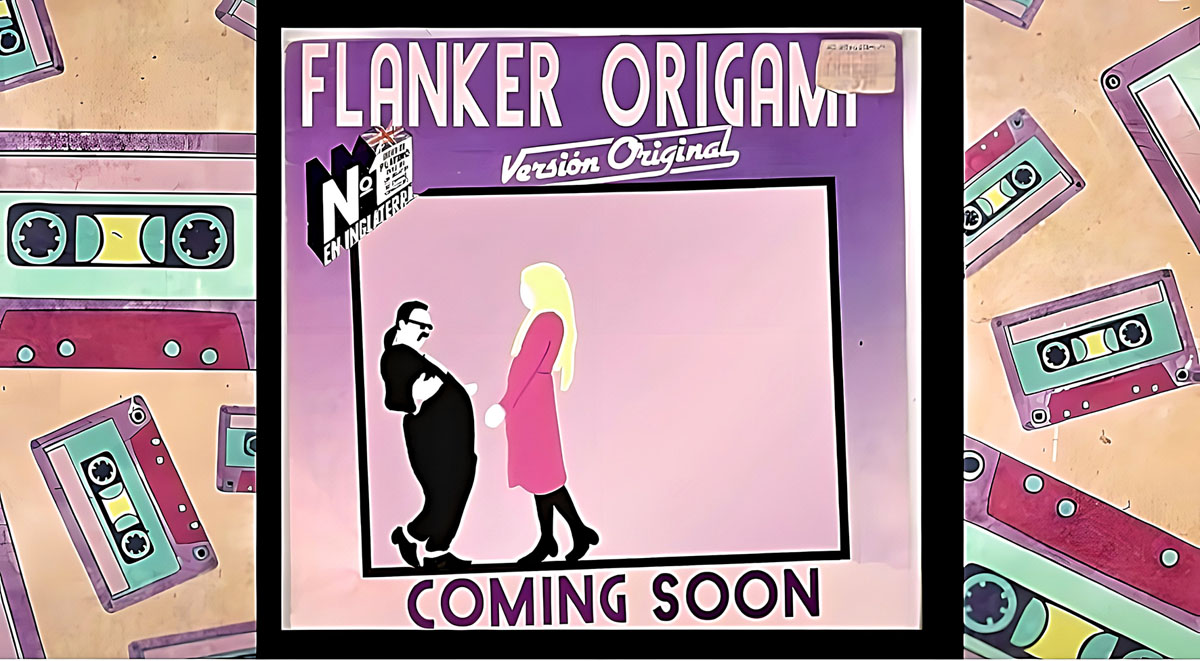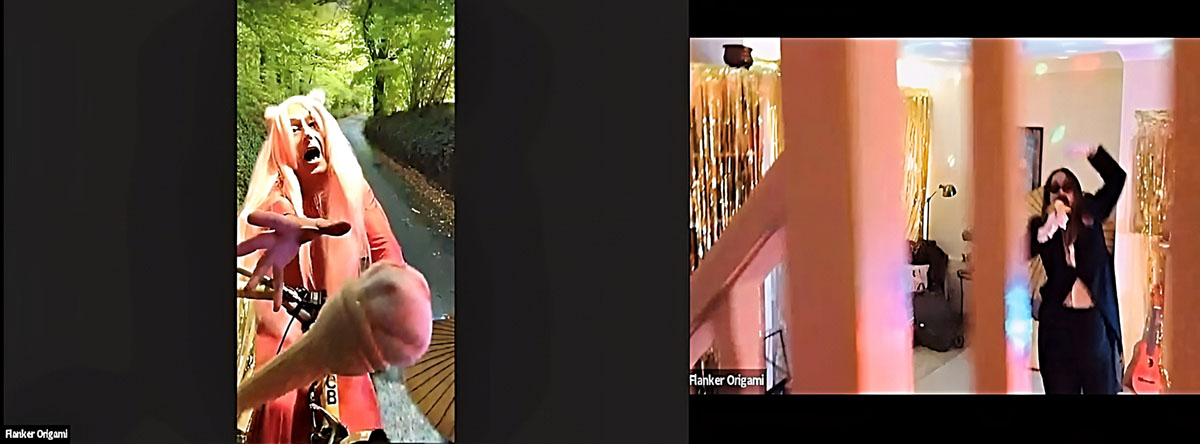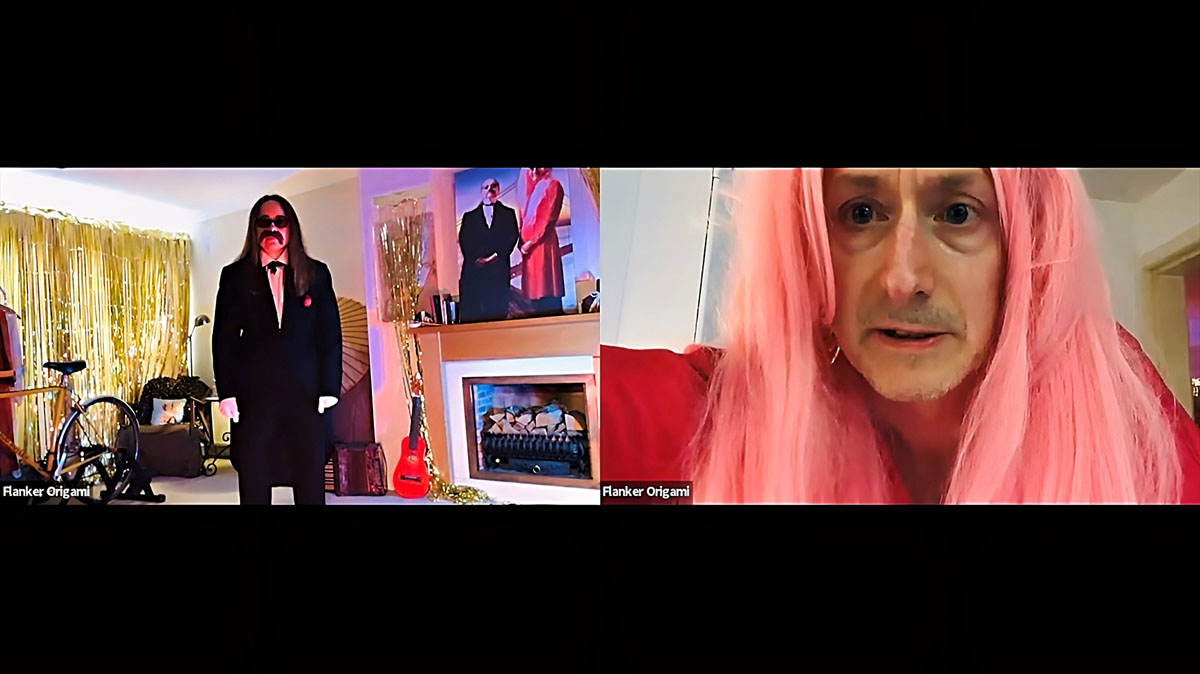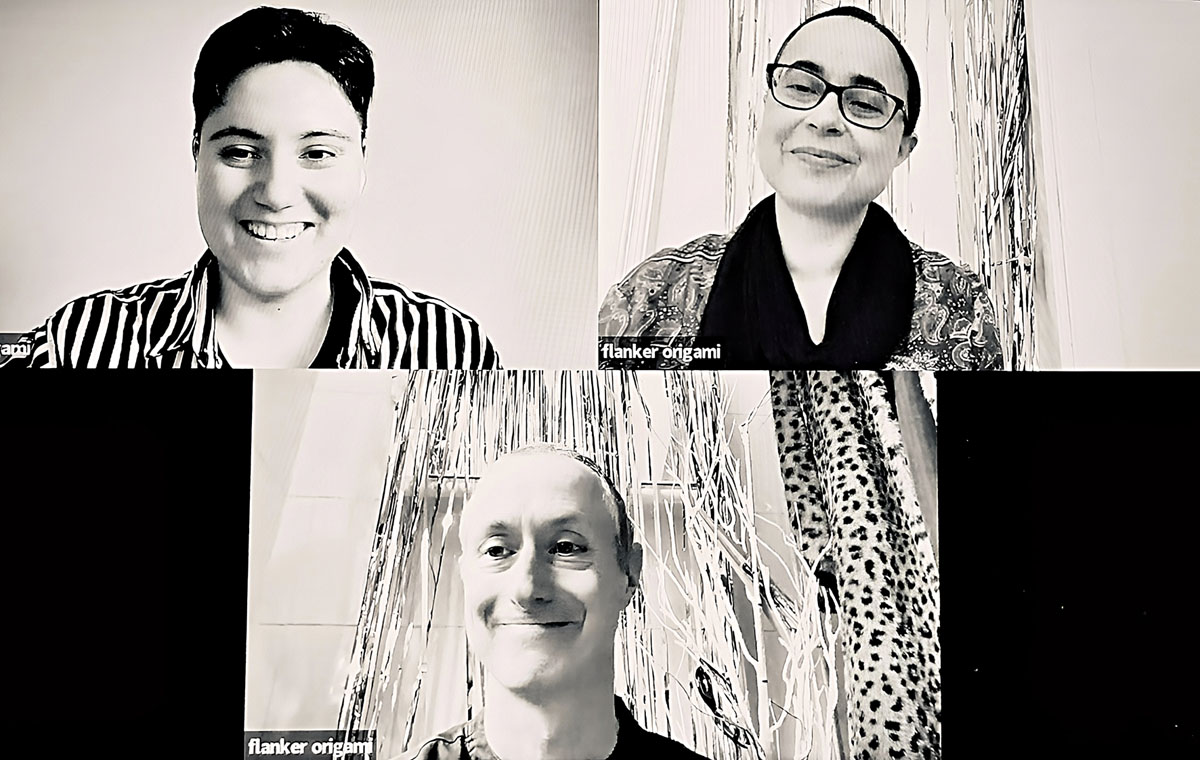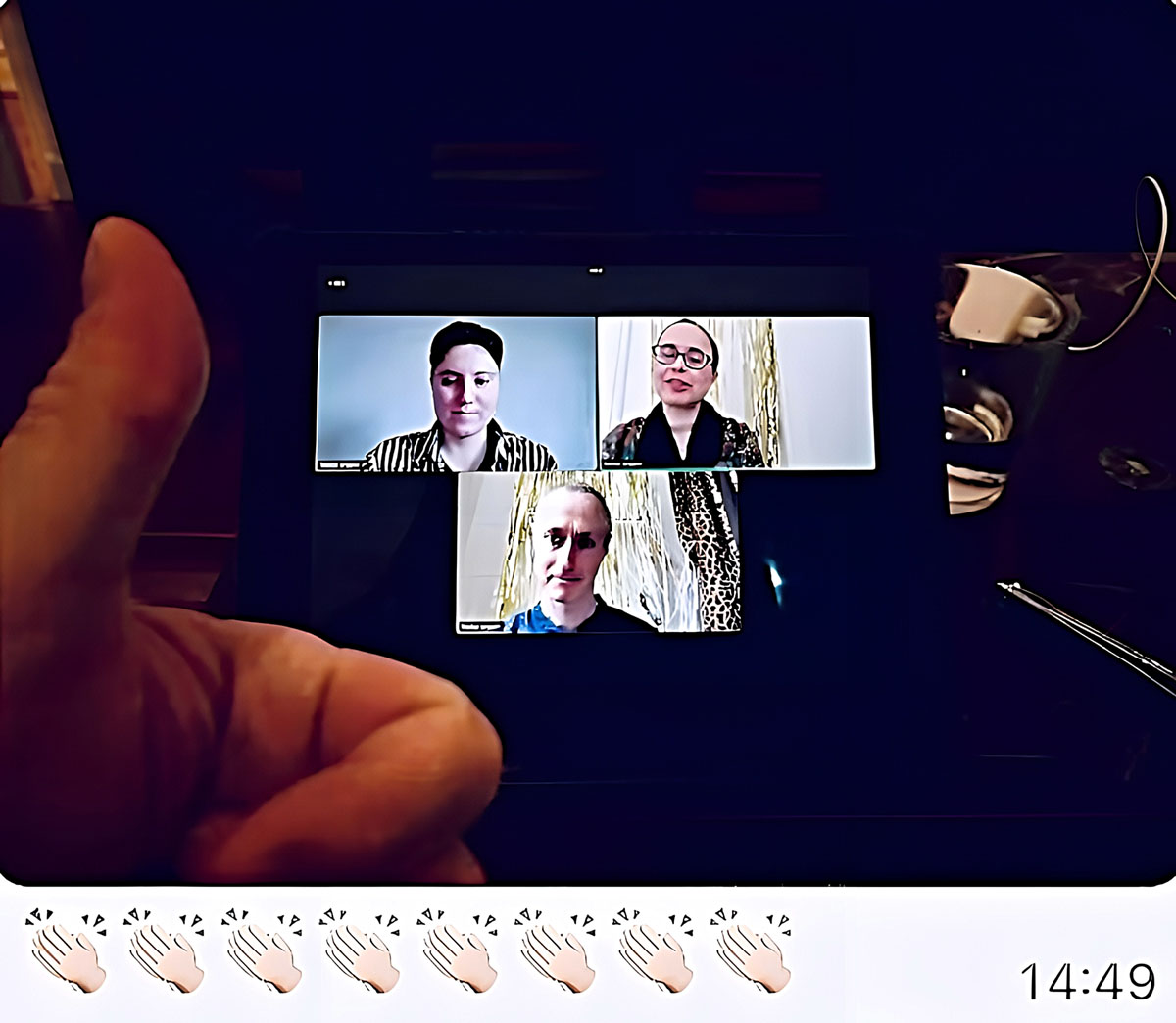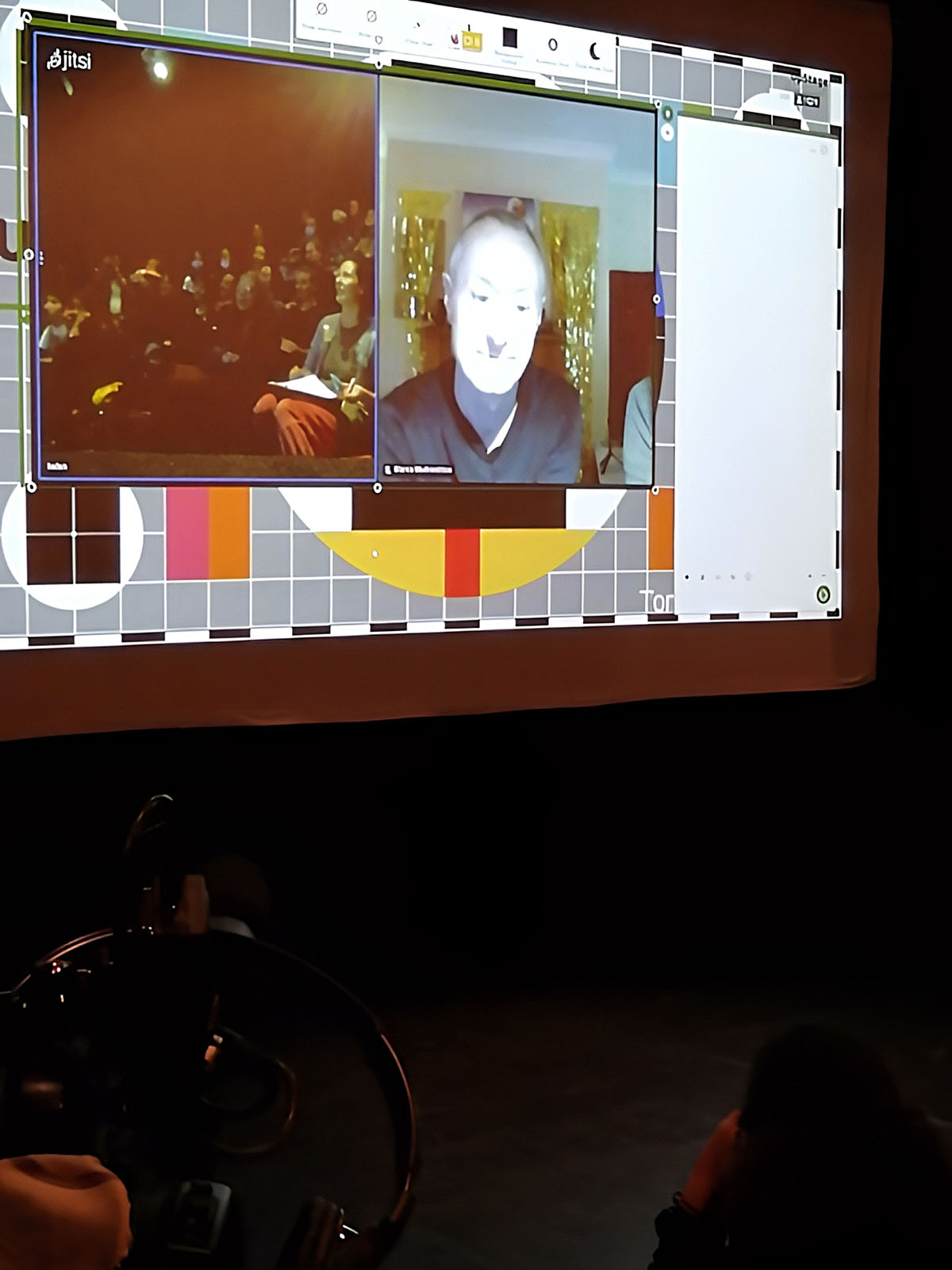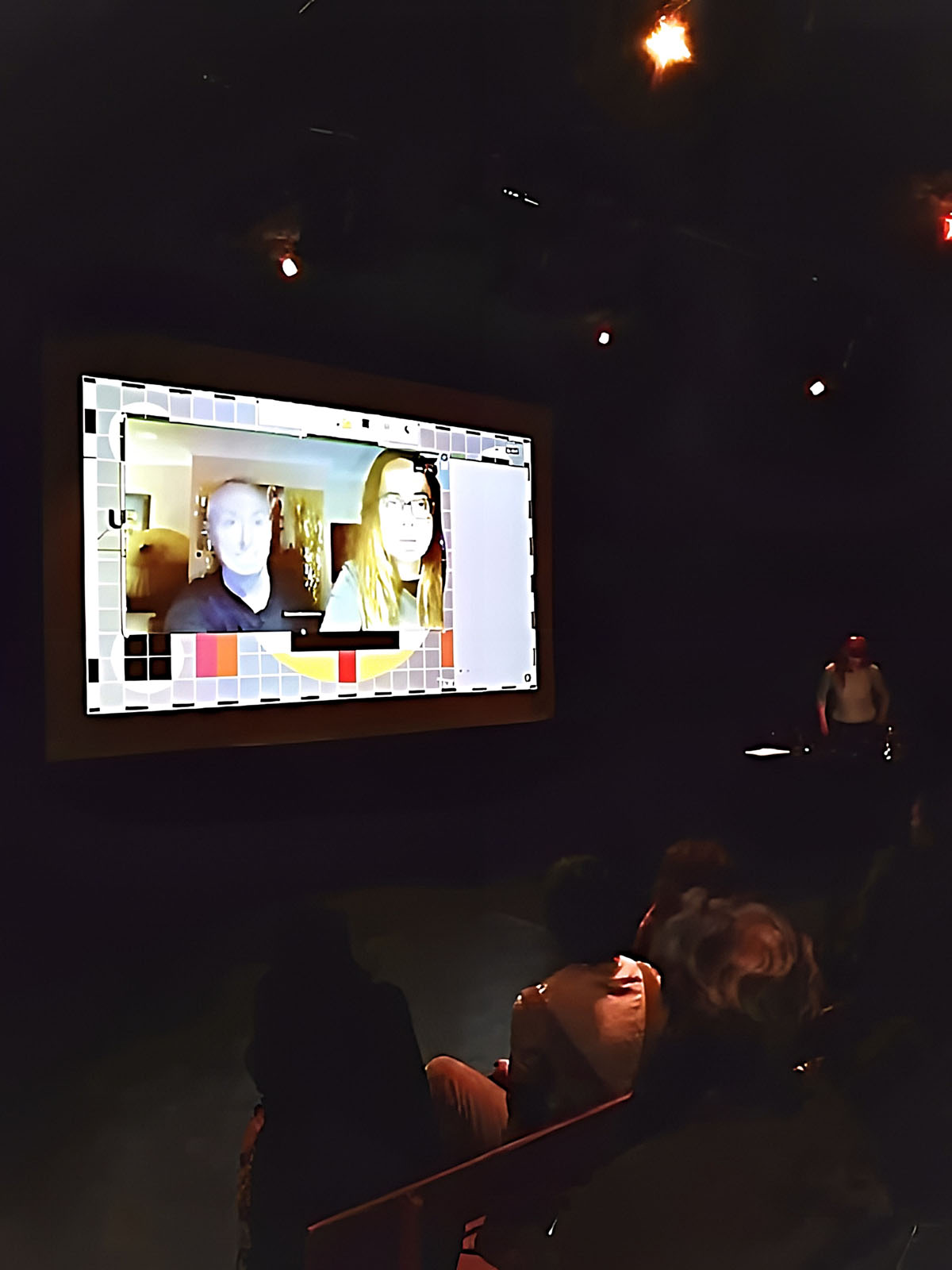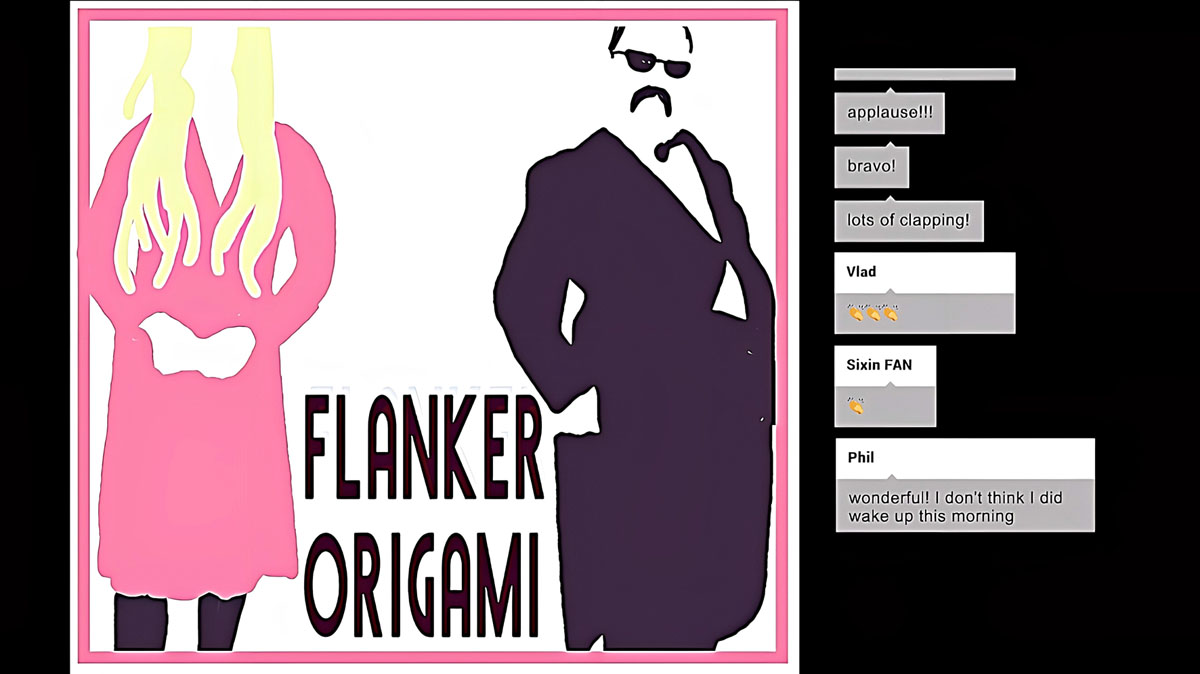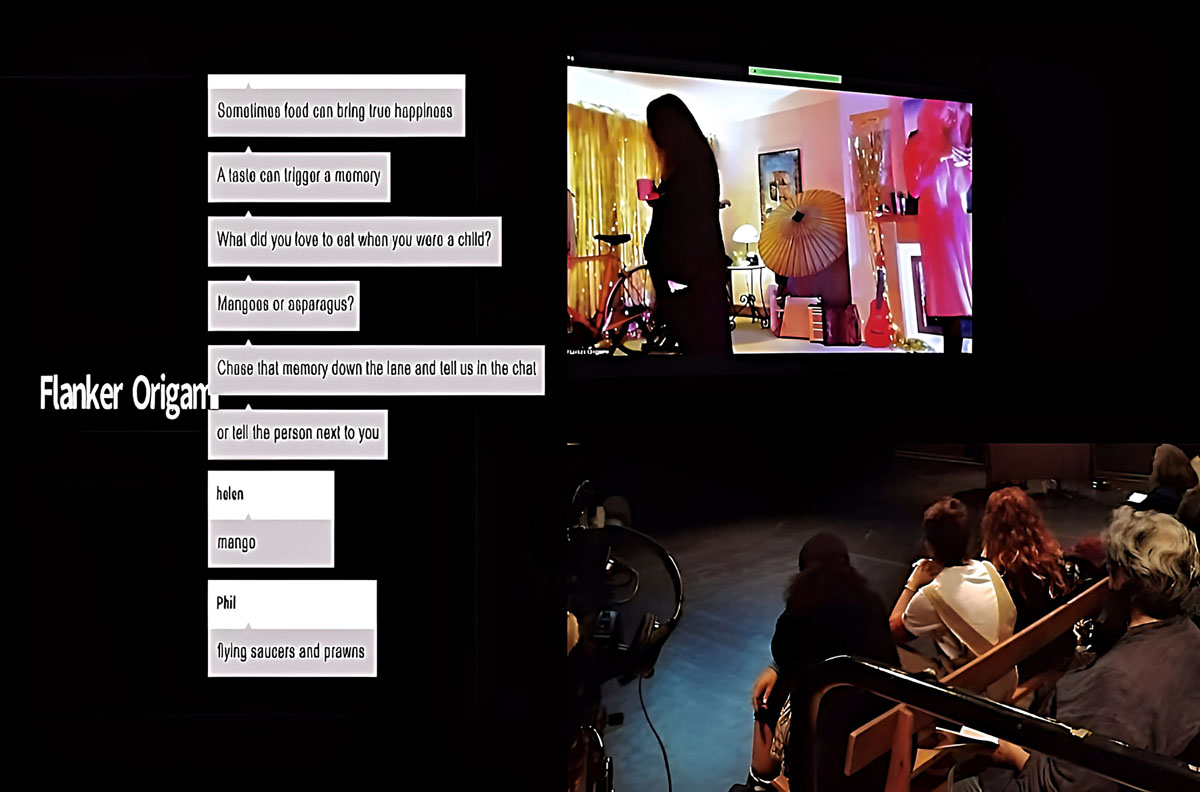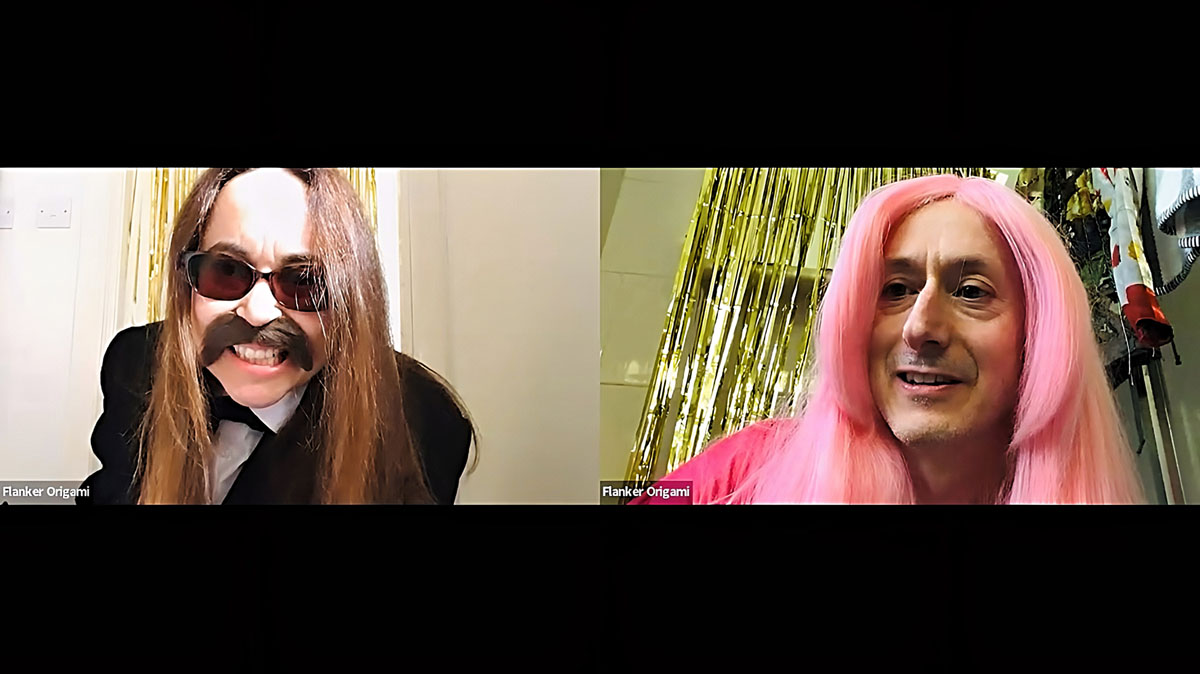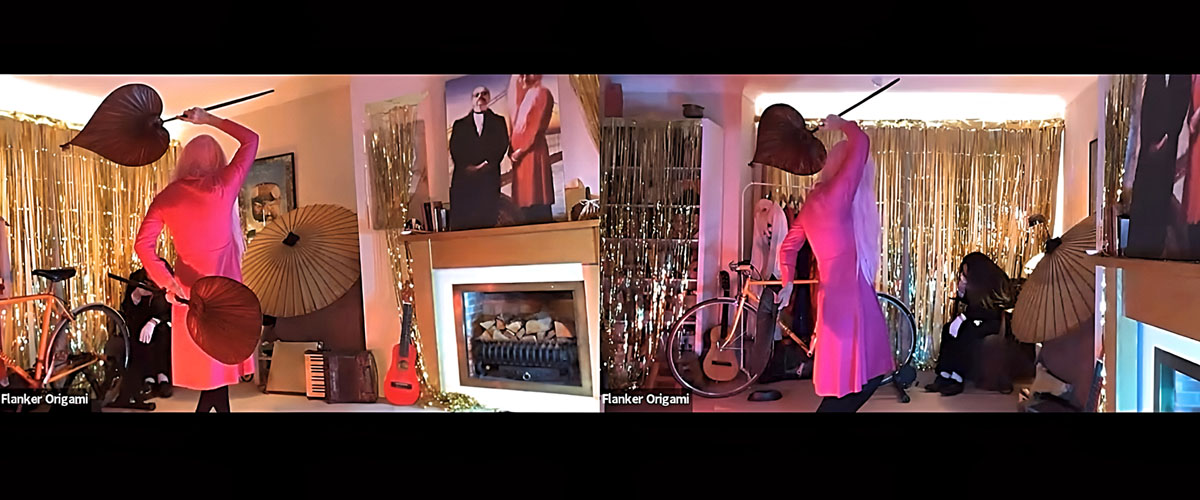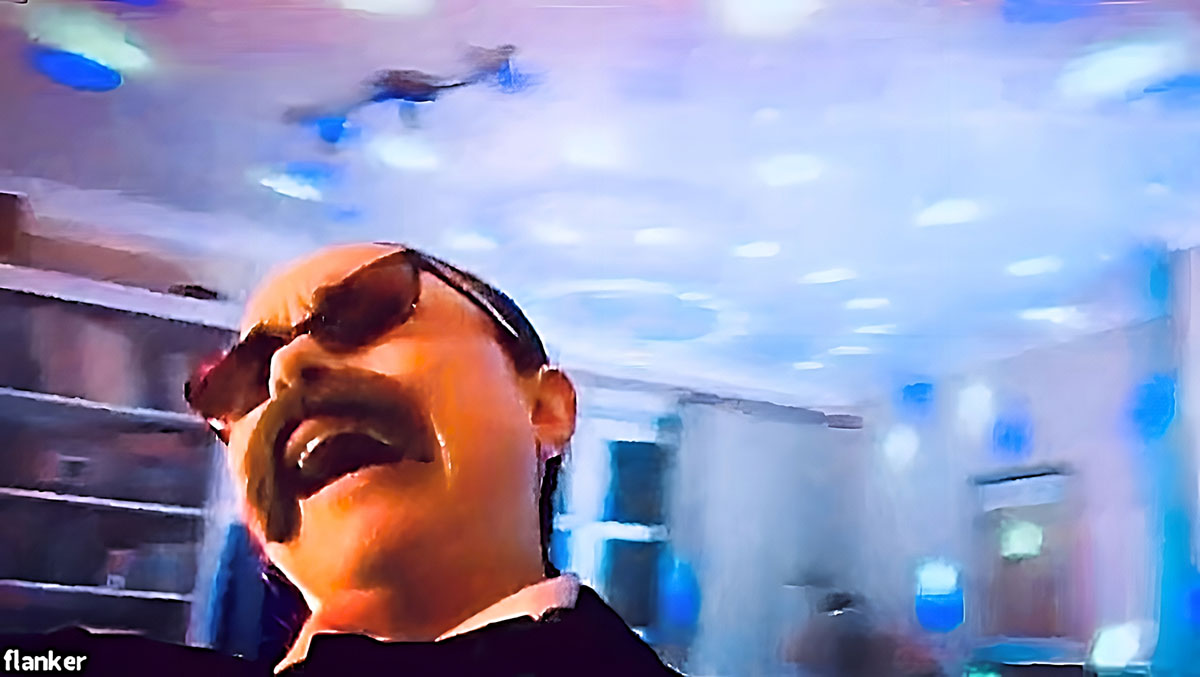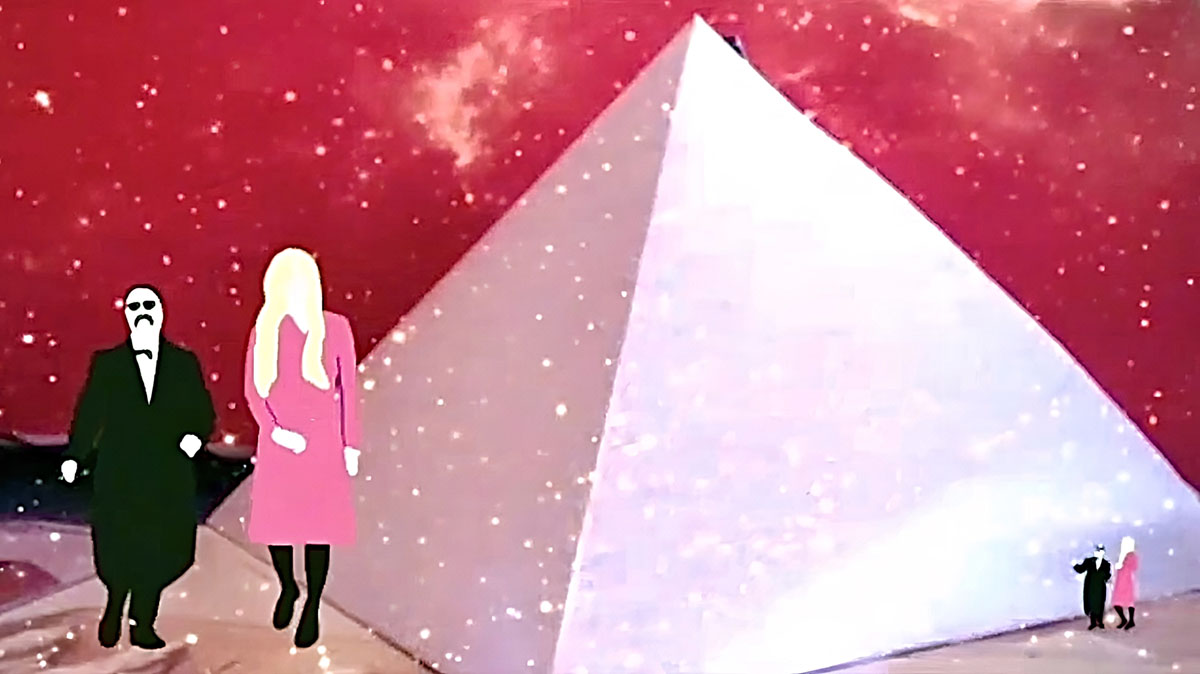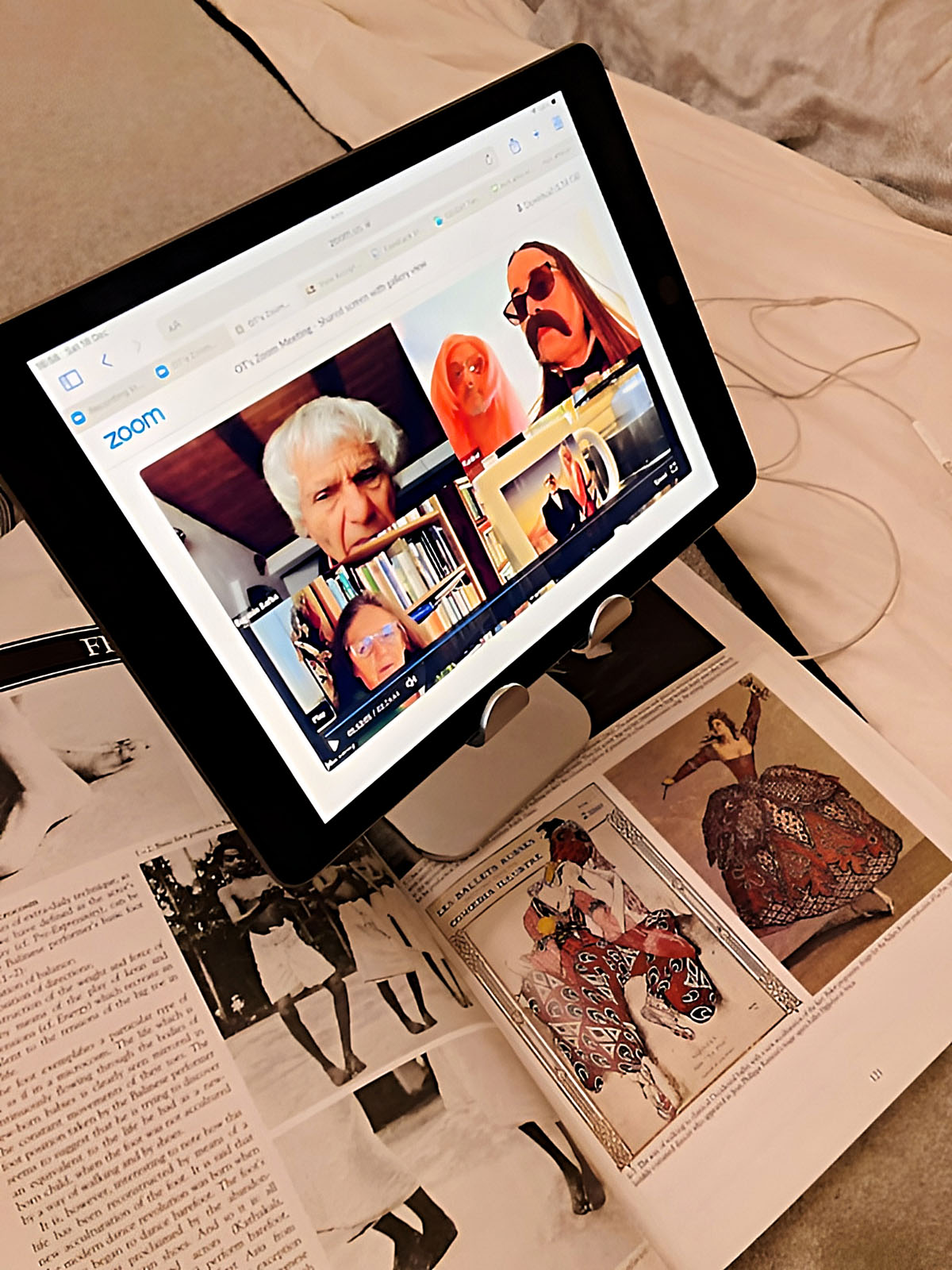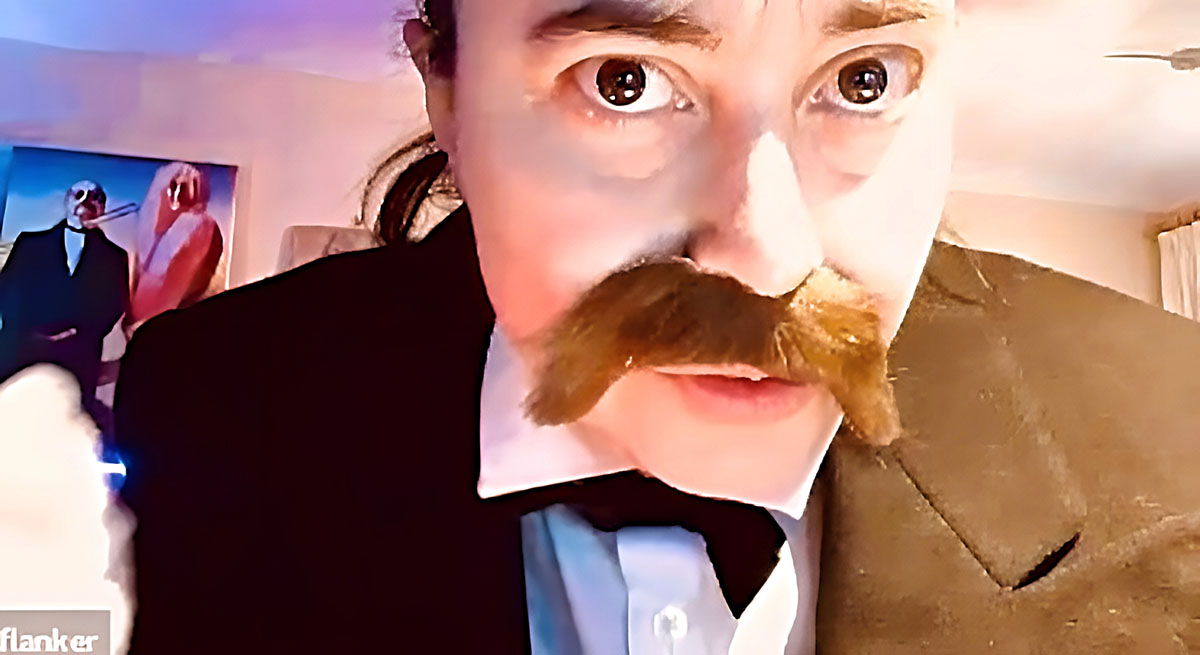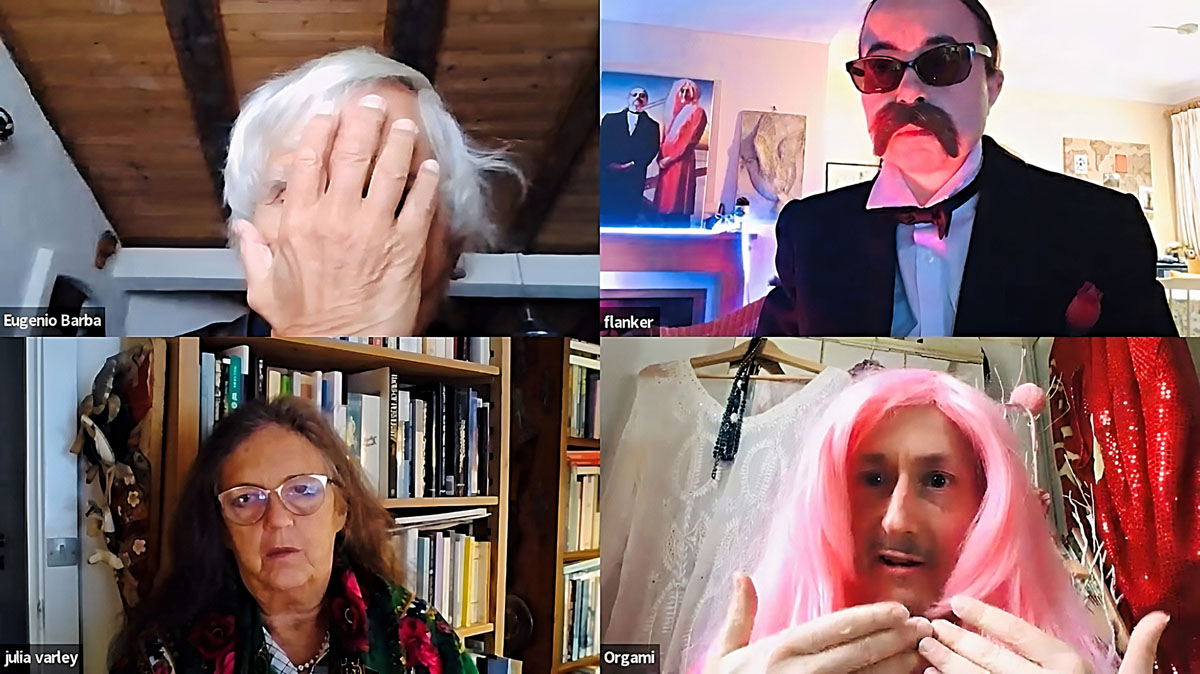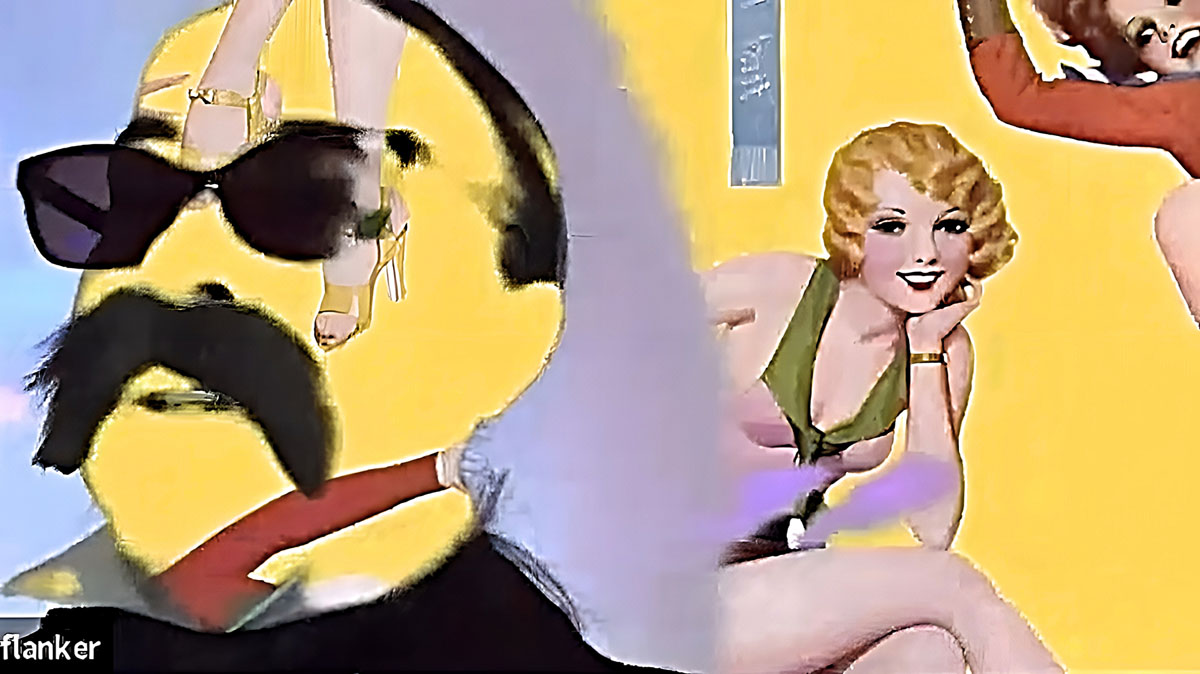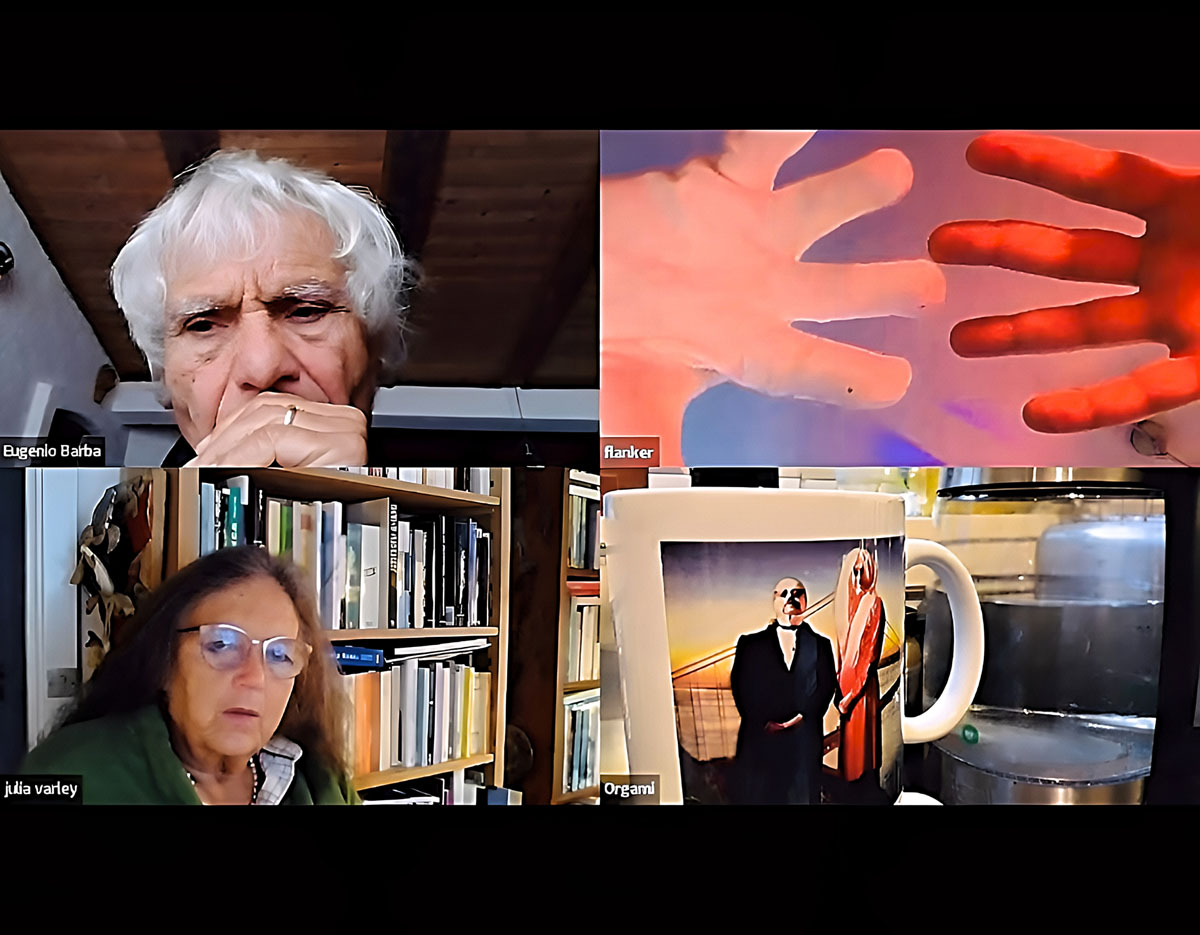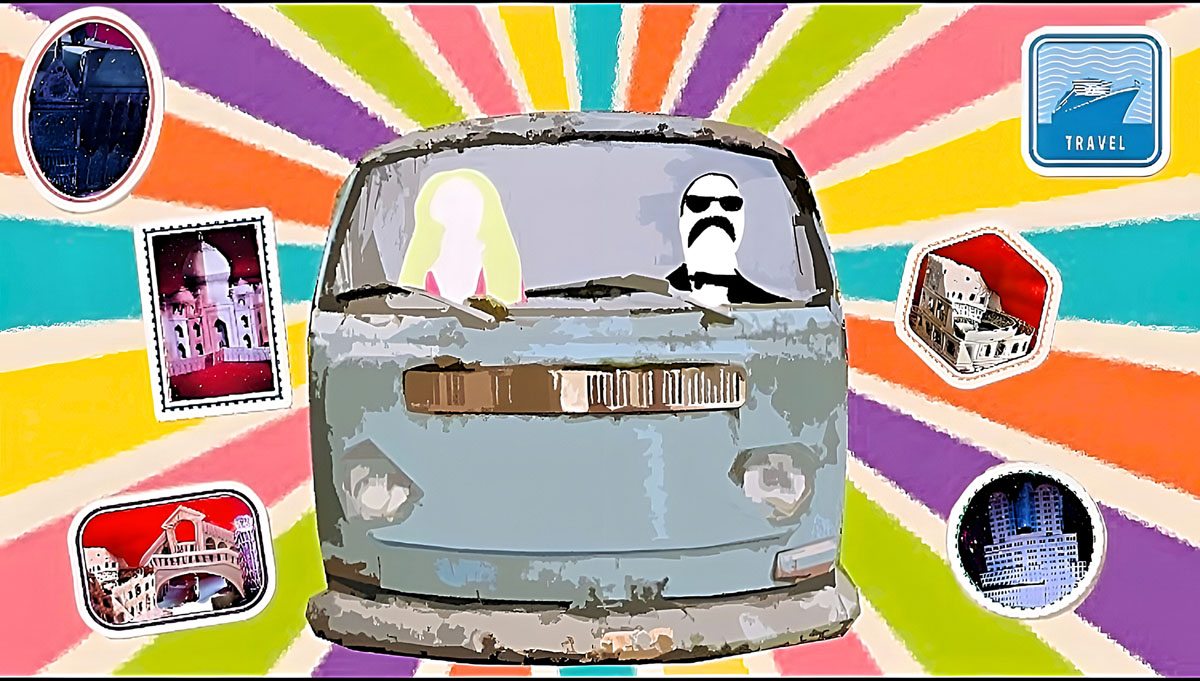Introduction
This article analyses and discusses digital spectatorship within a longitudinal practice research process started at the onset of 2020, through shifting training and performance practice from working in studio to the Zoom video call application. It is based on my creative work as part of Organic Theatre and uses as a case study Flanker Origami, a live online performance devised and performed via Zoom webinar by myself with actor and director John Dean (Figure 1). The performance premiered in 2021 within the first digital programme of the Edinburgh Festival Fringe, before touring online venues and festivals in Italy, Denmark and Hong Kong. From an initial pretext of being creatively resilient at home in lockdown and despite social restrictions, for two and a half years, Dean and I – a couple in life and art – have embarked in an ongoing exploration of digital performance training and making. Within this personal digital adaptation, Flanker Origami has become the first performance iteration in a series of practice research outputs, which explore connection and affect between performers and spectators in online shifts of performance practice driven by the pandemic. Flanker Origami plays with our identity as an artistic couple, engendering an alternative online reality in a (real) house via two cross-dressed and heightened alter egos. The performance unfolds through an absurdist sequence of participatory wellbeing rituals in a situation of home confinement. These range from sharing lucid dreams from the bathroom via the chat box, holding a dance class in the lounge, reading love stories in a cupboard and engaging in a redemption memory exercise while riding a stationary bike (Figure 2). The suggestion to the spectators is that these routines are intended to enhance social grooming, and will ultimately generate good feelings in those attending the webinar. While the activities seem to point at the saturation of self-healing resources circulating online during the pandemic and beyond, within the performance they become the thread that connects Flanker and Origami with their online audience through an invented and rather desperate self-care repertoire. With the webinar progressing and Zoom fatigue kicking in, each ritual aggravates the sense of discomfort and inner isolation experienced by the cross-dressed couple, exposing the brutal reality of a relationship threatened by living in constant survival mode.
Through reciprocal manipulation and holding tight to the digital theatrical veneer and gender reversal game, the online complicity deteriorates into a power struggle, which exploits gender inequality, hints at domestic abuse and reveals the fragility of their day-to-day existence caused by lack of social contact. In the final fitness routine chosen by the spectators via Zoom poll, what rapidly unfolds – bringing the couple’s day and the webinar to a closure – is a neurotic existential crisis, forcing Flanker and Origami into a silent admission that one can be distant and apart even when sharing the same living space. The rituals end with the broadcasting of the couple’s 2D rotoscope animated fantasy of themselves, repetitively performing their invented dance in and out of heritage sites, pop-up cities and landscapes emptied of humankind.
Thematically Flanker Origami is a performance about the impact of a global health threat, investigating how enduring social restrictions have made us vulnerable and edgy. However, instead of a linear narrative, spectators are confronted with and asked to react to the apparent serendipity of a digital dramaturgy, where ‘autobiographical material feeds into tall tales’, and the performances ‘are held a paper thin distance from us’ (Mastrominico and Dean 2021).
On the Zoom webinar, spectators are given the chance to be voyeurs of personal spaces (Figure 3), and are addressed and invited to respond and integrate themselves via the chat function, while participating in an online behaviour which identifies with the shared critical circumstances of the pandemic. In this mediated intimacy, the performance creates an online interactive space, where the social tension of isolation can be released collectively, in the here and now of a levelled experience of remote interaction.
This analysis aims to appraise the role of digital spectators activated by participation and co-creation in a live online performance. It also focuses on how the performers negotiated and adjusted to the absence of spectators’ bodies in the room, when playing for the camera on the Zoom platform. Matthew Reason (2010: 28) observes that ‘audience responses to a performance […] can be considered a kind of countersignature […] a trace of the experience that also is a kind of experience in its own right (and therefore a trace of itself)’. Experimenting with co-presence and interactivity has led to considering the entanglements of physical and digital bodies, as well as how digital spectators might become co-creators through technologically enabled dynamics of participation. My enquiry is based on the observation of these dynamics, tracking and analysing audience behaviour during and after the performance. For example, as seen in Figure 4–5, Flanker Origami’s spectators might decide to actively document and share their post-performance engagement in real time with the company via social media, thus valuing the live online interaction in a way that also underlines co-presence beyond the event itself.
The first part of this article aims to provide evidence of how spectatorship is activated in Flanker Origami to generate instances of co-creation, and addresses the direct involvement of spectators in the open-ended and interactive structure of the performers’ wellbeing rituals (Figure 6). This section also evaluates audience responses, articulating multiple experiences of spectatorship. In the second part, I examine digital spectatorship and co-creation through analysis of an online knowledge exchange meeting and mentoring process, which occurred on 1st December 2021 on Zoom between Eugenio Barba, founder and artistic director of Odin Teatret, Julia Varley, actress at Odin Teatret, writer and director, and myself and Dean as Organic Theatre. In the meeting, the digital know-how and the technical work behind Flanker Origami were exposed, opening discussions about the cinematic nature of the digital montage, as well as strategies to theatricalize the digital image. I will discuss how encountering the rigorous vision of Varley and Barba on Zoom provided stimuli for practical tasks that evolved the performers’ dramaturgy and presence on the platform.
Methodologies and ethics of care
As Reason (2010: 16) notes ‘the qualities of our epistemology (our way of thinking) when dealing with people-based research are fundamentally affected by the nature of our research process’. While ethical approval for this research has been granted by Queen Margaret University (Edinburgh), and consent has been obtained to publish spectators’ responses, it is crucial to stress that participation and interaction during the performance were voluntary and could be anonymous. Moreover, spectators’ questions, comments and feedback discussed were not solicited by myself as a practitioner researcher, nor at any point were spectators asked to engage with the performance for the purpose of delivering feedback. Those attending the Q&As were made aware of the company’s intention to record the post-performance discussions for research purposes and consent was sought prior to recording.
An ethic of care underpins the digital protocols of the performance. Invited to contribute and interact with the performers via chat during the performance, spectators have the choice to remain anonymous in their participation, as well as to rename themselves in the webinar (e.g. with nicknames, their initials, letters or symbols, or a combination of these). Participation in Q&As (Figures 7–8) is voluntary, and there is no obligation or expectation that the spectators would remain connected post-performance. During the discussion, the default suggestion by the company’s digital technical manager is to post questions and/or comments in the chat, which can be read out on their behalf, if preferred.
The interconnected experiences of spectatorship influence the digital praxis of the performers, as well as the practice research methodologies adopted, which include:
Tracking and measuring spectators’ engagement with the Flanker Origami routines through performers’ notes and Zoom recordings of the performances (Figure 9).
Observing spectators’ reactions to different iterations of the performance (Figure 10) through a span of time, as well as their articulation of how their experience changed between viewings.
Collating documentation of spectators’ responses from online audience reviews, post-performance Q&As on Zoom, emails, social media conversations and messaging via Twitter, Facebook and WhatsApp.
Instigating a two-hour online knowledge exchange and mentoring meeting with Odin Teatret’s Julia Varley and Eugenio Barba, to provoke, observe and analyse instances of digital spectatorship and co-creation in a (digital) laboratory-like condition.
Analysing qualitative data gathered from Zoom recordings of performances, Q&As, and online meetings through listing and transcribing spectators’ questions and comments, as well as collating the performers’ answers and transcribing dialogical exchanges for further analysis.
Theoretical frameworks
According to feminist cultural theorist Karen Barad (2018: 231) ‘apparatuses are constituted through particular practices that are perpetually open to rearrangements, rearticulations, and other reworkings […] Boundaries do not sit still’. As a performer and a practitioner researcher critically evaluating co-presence in an online interaction which I have instigated, I observe that through the apparatus of the technology, methodological ‘boundaries’ indeed ‘do not sit still’. On the contrary, they become porous and ‘open to rearrangements’ due to the interactivity and participatory practice of spectators and performers in Flanker Origami. As the performer-enabler of digital spectatorship through an online platform, in my investigation I am confronted with feminist philosopher Rosi Braidotti’s (2013: 89) definition of the posthuman as ‘a becoming-machine’, in that ‘the relationship between the human and the technological other has shifted in the contemporary context, to reach unprecedented degrees of intimacy and intrusion’. Similarly, I am addressing processes of posthuman connectivity (Braidotti and Åsberg 2018), which in the context of this enquiry refer to:
How spectators experience the entanglement with the performers as digital entities.
How they engage in performative interactions through the technology, and how they respond to/in the participation.
How this state of responsiveness continues for the spectators and transforms into an unsolicited wanting to share their experience of the performance.
Therefore, within my practice research, new materialism and posthuman epistemologies provide a valuable way of thinking about ‘the impact of technoembodiment and digital mediation’ (Braidotti and Åsberg 2018: 7) on the entanglement between spectators and performers. From a posthuman perspective, active spectatorship and co-creation can also be intended as a way of reworking, rearticulating and rearranging who is in charge of the meaning-making in any given moment within the live online interaction.
Methodological implications
As artist and scholar Maria Chatzichristodoulou (2017) observes ‘performance encounters in and through the digital can, and do, expand, challenge, resist, and/or subvert aspects of digital culture. In doing so they facilitate a critical engagement with our digital condition not just in theatre, but also in life’. Critically engaging on Zoom with the formidable theatrical experience and embodied knowledge of Julia Varley and Eugenio Barba, might feel slightly at odds not only within the context of digital performance practice, but also considering the long history of Odin Teatret’s cross-cultural live practice rooted in performer training, performance making and the craft of theatre directing. Moreover, neither Varley or Barba felt a need to migrate their own performance practice online, while being able to continue working in person in Holstebro (Denmark) during the Covid19 restrictions. However, some of Odin Teatret’s pedagogical activities were shifted online, and Varley and Barba also decided to offer a digital course for the 2021 edition of the International School of Theatre Anthropology/New Generation to participants unable to make the journey to the island of Favignana in Italy at that time.
Due to these incursions in the realm of the digital, and of a longstanding artistic alliance with Organic Theatre over the past twenty years, the methodological predicament of the meeting with Varley and Barba was to work in a (digital) theatre laboratory condition, appraising ‘subjectivity as an assemblage that includes non-human agents’ (Braidotti 2013: 82). This would have entailed practicing and observing how the assumption of boundaries between physical and digital embodiment would shift in their perception as digital spectators.
The first-hand experience and documentation of Varley and Barba’s extreme precision towards the craft and their quality of observation in relation to a precarious, apparently marginal, emergency performance act on Zoom, provided vital information on the spectator’s perception and reading of Flanker Origami. In this context, it is considered pertinent and relevant to refer to the Zoom meeting with Varley and Barba as a practice research methodology aimed at provoking a shift in knowledge in relation to the mediated encounter, while also overtly experimenting with co-creation on Zoom. Within the meeting itself, the primary methodology rested with Varley and Barba’s gaze, as their exceptionally trained eyes and embodied practice also defy and reframe notions of disembodiment in live online performance, which appeared to be the main conceptual impasse for many practitioners and theatre makers shifting work onto digital platforms during the pandemic. As pioneer of cyberformance Helen Varley Jamieson (2015) states ‘I don’t think of virtual space as being disembodied. We are still in our bodies, we are using our bodies to create performance’. This echoes L.M. Sacasas (2021) observing that ‘we never actually leave our bodies when we use digital media’, as well as Joanne Scott (2022) who notes that ‘when we physically interact with keyboards, mouses, cameras and microphones, data passes from our bodies into the event and back from the [online performance] event into our bodies’. In agreement with these positions, I shall now discuss how digital (a)liveness is created through online spectators technologically interfering with (or actuating co-creation in) the process of performing Flanker Origami.
Part One – Virtually Connected
As a live performance happening through a video call application, Flanker Origami can be appraised as a ‘computationally centred’ performance in that ‘the device and its processes necessarily sit at the centre of the work as a node of connection between the physically distant bodies in play’ (Scott 2022). These working conditions demand that both performers and spectators embrace what Susan Broadhurst and Josephine Machon (2006: xvi) call ‘the inherent tensions between the physical and the virtual’, while the performers are engaging with ‘a temporally co-present, but unseen audience’ (Scott 2022). In attempting to generate co-presence, a search for (a)liveness underpins the performance process (Figure 11). Key historical contributions to the liveness debate, such as those (constantly updated) by Phillip Auslander, nowadays appear to be enriched and somehow complicated by increasingly sophisticated and enmeshed digital interactivity. Beside this, I argue that an unprecedented experimentation in digital performance encounters over the temporal arch of the Covid19 pandemic has seen bolder explorations in the realm of digital corporeality, and more entangled relationships with new technologies developing for both performers and spectators. Auslander (2012: 10) states that the experience of digital liveness ‘results from our conscious act of grasping virtual entities as live in response to the claims they make on us’. Rather than referring to an ontology of liveness for the digital medium, this practice research is more concerned with liveness as ‘the opposite of deadliness’ (Reason and Lindelof 2016: 12), and as an experience inscribed in the encounter between spectators and performance in the particular social context of the Covid-19 pandemic. Flanker Origami sets up spectators to interact with a performance, which is based on a shared experience of digital connectedness. In this respect, Christina Papagiannouli (2016: 9) specifies that in online theatre it is ‘the interactive participation of the audience in real time’ which engenders ‘the co-presence of actors and spectators in cyberspace’, and gives meaning to liveness. Most recently, in proposing a ‘datalogical analysis’ of online performance Scott (2022) states that ‘in the context of computationally centred, online practices, our experience of liveness is a construct and a by-product’. Acknowledging and embracing these definitions and insights, I aim to discuss how active spectatorship and co-creation might help generate a sense of liveness in Flanker Origami.
According to Jacques Rancière (2009: 17) ‘we do not have to transform spectators into actors […] every spectator is already an actor in her story; every actor […] is the spectator of the same story.’ Following this statement, I argue that active spectatorship occurs when, as Erika Fischer-Lichte (2008: 33) writes, it is ‘evidently impossible for the spectators to maintain their traditional position of distanced or empathetic observers’. Livestreamed on two Zoom windows, as screen-bubbles of the two characters of Flanker and Origami, the digital spectator is confronted with changes in backgrounds and perspectives, and with contrasting or parallel images of the same physical space inhabited digitally by the performers (Figure 12). This modulation of the digital space through a constant process of auto-framing asks the spectators to ‘independently prioritize their sensorial impressions’ (2008: 33) and make a choice about which frame to follow, and where to put their attention.
The digital medium becomes the space where the spectator can be implicated through shared playfulness, as from a phenomenological perspective, connecting on virtual spaces does not change that ‘not only are we born into sociality but our sociality goes to the roots of our being’ (Daly 2016: 31). At the same time in Flanker Origami the social interplay is not a solitary adventure, but it happens between the spectators themselves. For example, when interacting with the performers via Zoom chat, audience members might be inspired by other co-players to interact as well. They might be responding to one another, or just adding themselves when it feels appropriate, thus becoming co-creators not only with the performers, but with each other.
Active spectatorship and co-creation are generated through the performers’ online wellbeing rituals, most notably when spectators are openly invited:
To share lucid dreams via chat.
To learn and perform a sequence of original dance moves in their own physical spaces (with accessible adaptations).
To retrieve happy memories about food and post them on the chat.
To vote (via a Poll) which fitness routine should end the webinar.
To use the chat at the end of the performance for final comments, emoticons and reactions.
While the performers do not need to see the audience performing the routines to carry them out themselves (Figure 13), these are intended for the spectators to participate, empathise, affect the performance and be affected. As cognitive neuroscientist Vittorio Gallese (2012: 57) explains in relation to the role of mirror neurons and embodied simulation in social connectedness ‘when observing other acting individuals, and facing their full range of expressive power (the way they act, the emotions and feelings they display), a meaningful embodied interpersonal link is automatically established’. This affective link is nurtured by the presence of the performers, which Eugenio Barba (2022: 13) defines as ‘the sensorial dimension of a personal knowledge and a historical experience in a subliminal dialogue with the spectators’ physical/archaic memory and the maze of their minds’. When not interacting in real time with Flanker and Origami, spectators are constantly implicated in the online action and through direct address by the performers, involving them in the voyeuristic feeling of seeing something, which shouldn’t be seen – a digital intimacy through camera work, self-montage, and close-ups intruding over acts of vulnerability in the couple’s online behaviour. Despite this, spectators are conscious that they are not seen to be seeing by the performers. This awareness, which pertains to the experience of spectatorship on a Zoom webinar, seems to generate a necessity from audience members to let the performers know what they did, and how they reacted in the moment of participation. The sharing of spectators’ behaviour through pictures and comments during or post-performance becomes a very useful tool for the performers to gain clues of how spectators are affected by their action, which in turn enhances their effort and understanding of how to assert co-presence and generate co-creation in real time.
Audience entanglements and co-creation through the chat box
In Flanker Origami, spectators can access the chat box all the way through the performance. The first offer to write dreams on the chat comes from the character of Origami, who starts posting hers, while Flanker offers spontaneous oral interpretations of Origami’s and the spectators’ dreams. The interaction via chat is improvised, as performers and spectators cannot predict what will be posted, and there is no fixed script for this section. The exchange sets the nature of the complicit relationship, which acknowledges the co-presence of the spectators through a playful act of reciprocal listening and responding. Experimenting live with relinquishing control over the chat box and according agency to the spectators, allows them to willingly enmesh with the affective situation created by the performers through the medium. According to Chris Salter (2010: xxxii) this kind of entanglement ‘suggests that human and technical beings and processes are so intimately bound up in a conglomeration of relations that it makes it difficult, if not impossible to tease out separate essences for each’ ( (Figure 14). The open-ended aspect of this kind of engagement means that with the chat box available to the spectators, there is always the potential occurrence that ‘the audience will communicate with one another (and with the administrator and the technician of the streaming)’ and will ‘respond to the performance in real time’ (Papagiannouli 2016: 22). Once connection via chat is established, unplanned communication or unsolicited posts might become a disruption or an interference, which requires that the performers remain open to adjusting to the spectators’ reactions. There is a co-creating potential in knowing that the performance could be heckled at any time by posting comments and reactions on the chat. This is not a new digital behaviour, as it is embedded, for example, in the longstanding experimentation of Jamieson’s networked practice of cyberformance on artist-made cyberstages such as the UpStage platform, where cyberperformers juxtapose with and incorporate comments on the chat posted by their online audience. As Jamieson (2015) observes, in this different kind of behaviour there is ‘a level of familiarity and equality, as opposed to the separation of the 4th wall in traditional theatre’. Similarly, Flanker Origami seeks to establish a level of ‘equality’ between performers and spectators via the chat.
While performers navigate the edges of digital audience participation through alluding to, suggesting and simulating a collective necessity to perform their online wellbeing rituals, the actual decision to take part and become co-creators resides entirely with the individual spectators. This is also dependent on the technology used, the space they are in, their mobility, social settings, and personal circumstances, but also the mood of the moment, amongst other aspects. From this research it is understood that spectators watching in the same place and receiving the same invitation to engage with the routines, might react differently from one another, which adds to the complexity of the human responses, and the sociomateriality at play within technologically enabled performances.
Part Two – A Zoom Encounter with Odin Teatret
From my embodied experience as a performer, digital liveness is a process activated through the participation of the spectator in what I define as an ‘ecology of becoming’ (Mastrominico 2021), intended as a continuum in performance behaviour which is enmeshed with and fluidly transformed by the technology and surrounding sociomaterial elements. In this second part, I examine the emergence of such an ecology and its impact on Flanker Origami through analysis of video documentation of a Zoom meeting with Julia Varley and Eugenio Barba (Odin Teatret) in December 2021, where for two hours they connected from their own houses in Denmark with Dean and I in Scotland (Figure 15). As we were entering a new stage of the pandemic, it was felt that more exploration and research was needed to generate a new performance iteration, therefore the online exchange and mentoring process with Varley and Barba was particularly influential in consolidating and expanding our digital practice. Both Dean and myself have seen and taken part in the work of Odin Teatret in person many times, as well as through video and film documentation, while also facilitating a UK wide tour for the company in 2005. However, the process of working with Varley and Barba on Zoom has brought reflections on the difference between the dynamics of apprenticeship and transmission I have usually experienced, and those at play through the digital medium. Their intersecting expertise on performer training and theatre anthropology, and how embodied knowledge could manifest on Zoom, leads to the reflection that “working through digital platforms, the remoteness of the performer-spectator interaction establishes presence through what is experienced and perceived as absence. This apparent paradox […] requires experimenting with principles and working techniques that enable performers to embody “essence through absence” in the digital realm’ (Mastrominico 2022: 274).
In analysing the recording of the meeting, I firstly observe how the energy of our interactions on Zoom regulated the exchange. As the medium forced us to pay particular attention to the way we communicated between digital screens, the intermittences, lags and glitches merged with the attempt to recreate a sense of physical closeness, and the need to be precise while interacting creatively. The meeting was kept informal, as the focus was not so much on our performance as an outcome, as on the perceptions of Varley and Barba of what they were experiencing on digital. The temperature in the virtual space rose as the screens were activated by Dean and I in the Flanker Origami costumes, responding to their observations, while we were framing ourselves for the camera. We chose to share our performance personas in the house-set, alongside unrelated fragments from our dramaturgical scores, so that these could be discussed technically and in terms of digital craft, more than as a fixed artistic result. Throughout the meeting, both Varley and Barba were spontaneously reacting to the performance fragments, while working in digital laboratory conditions. This allowed their responsiveness to our presence as Flanker and Origami to become central to the meeting (Figure 16), instead of our dramaturgical intentions. We were operating at what is referred to in theatre anthropology as ‘the pre-expressive level’ (Barba and Savarese 1991: 218), working through the bios of the performers who are digitally embodying their material and conventions.
On the Zoom recording, Varley and Barba’s composure and neutral observation is noticeable. At the same time, energetically they both appear to be thinking with the body (Varley 2011), ready to pounce, though always waiting for the right moment to speak. Barba remains specific throughout the meeting in relation to the action of looking at and within the frame. Working through our digital images on his screen, Barba seems to engage intuitively with his kinaesthetic sense as a digital spectator. He refers to the visual as the main sense at work in our interaction, underlying the act of seeing in saying ‘when I see the image’ or ‘I see you as’ (Barba et al. 2021). Varley invites us to reflect on technical considerations, while Barba observes in silence for long stretches, looking intently at what Dean and I conjure, and listening to my explanations about the Flanker character, which do not necessarily coincide with the associations he had when seeing me in costume:
‘The perception of the spectators is completely different from that which the actor imagines; it should be possible to find a certain kind of logic, of visual coherence for these two figures who have potentially a great strength, which would work immediately on the perception of the viewer.’ (Barba et al. 2021)
When Varley starts speaking about the difficulty of communicating ‘when you don’t look straight into the camera eye, but look at the images of people on screen while talking’, I share our technical way of addressing the issue (Figure 17). I note that ‘instead of looking at each other, we both look into the camera and imagine the other is in the camera eye’ (Barba et al. 2021).
For Barba the focus is on including the spectator through looking into the camera:
‘My impression is that when Bianca was getting closer and was looking, I had the feeling that she was looking at John but also at me, that is that she would include me. Therefore there is a factor of how you get closer and move away from the camera, and at the same time where you look […]. You should give me the feeling of somebody who sees, though at the same time it includes me as well.’ (Barba et al. 2021)
Varley points at the oddness of a dialogue where the digital performers do not have ‘the same size or the same distance [from the camera]’ and which is not believable because ‘there is a very different measure of the faces’. While Dean articulates a desire of exploring ‘the idea of physical connection on screens [and] this game of distances’ (Barba et al. 2021), Barba starts experimenting with his hand moving from his face to the camera eye (Figure 18), sensing and measuring the energy field between him and the camera.
While Varley, Dean and I are interrogating the dramaturgical function of digital backgrounds, Barba continues to keep his eyes tight on us moving around the house spaces in our costumes, searching for ‘a visual effect which puts associations in motion’. In noticing that, as characters, we both wear sunglasses which erases or decreases the possibility of eye contact (Figure 19), Barba comments that:
‘The eyes are the spinal cord for the perception of the spectators, letting you understand where you look and see, and where you address the attention. When you eliminate them, you create a completely different perception for the spectators. It is like you are present at the same time you are hiding.’ (Barba et al. 2021)
During the meeting, Barba often reminded us that ‘I can only react to what I see’. In offering proposals such as ‘if you also cover your hair [ed. with a wig], what do you become?’, the notion of becoming as an act and a logic of continuous metamorphosis was made explicit. Our images were scrutinised for their transformative potential, instead of purely for what they might have or wanted to represent. From a performer’s perspective, Varley was keen to experiment with the body in the frame to construct micro-physical dramaturgies with us, while Barba warned that slowing our action down is crucial to the readability of what happens on screen. As we moved into experimenting with hands as characters meeting in the frame (Figure 20), Varley and Barba’s observation became vigilant and meticulous in checking that distances and symmetry were kept steady.
The creative possibilities of the screen-stage were explored, which led Barba to suggest that ‘you need to take advantage of all the possibilities that theatre allows, and that the digital medium allows’. One of which is the close up, which as Barba stated in the meeting, is difficult to do in theatre where ‘the spectators have the totality in front of them all the time’. He suggested that playing with the totality ‘and then only with a detail, and how the detail transforms and brings you into a specific direction’ would determine that ‘all the richness of the face, the make-up, the hair, the wig, should be used in a way or another’ (Barba et al. 2021). Varley, Dean and I speculated on what a spectator is on the digital medium. Using Dean’s metaphor of the ‘abyss’ to define the unseen behind the screen, Varley commented that for the actor the ‘spectator is the abyss, and it is also the black hole of the camera’, which is similar to traditional actors facing the proscenium arch, who have to deal with the black hole of the auditorium. Barba pointed at the rupture of illusion as a strategy to show a different reality on the digital screen, while Varley reiterated ‘I think you need to think one action at a time’ because, as Barba already mentioned, ‘rhythm is fundamental’ (Barba et al. 2021). On this Barba expanded:
‘What Julia says is very important, one needs to put in motion associations for the spectator, so that all the work is on the perception of the spectator. […] How do I build this situation? […] I have to invent a way where speed, acceleration, type of tensions, and in what direction the impulse goes and how I change it, are all factors which have an effect on the neuronal activity of the perception, that is on the brain of the spectator. You need to think all the time, how does everything that I do work for the perception of the spectator? If I do this movement [ed. Barba brings hands together as if pressing them against each other] what does the spectator associate with it? I associate that I am crushing something, or [ed. he changes energy in the same action] I am caressing something. Already these two internal actions totally change the tension of my hands, but also the perception and the rhythm. This needs to be like a reflex for the performer. You can do anything in improvisation, but then when you start refining and elaborating the montage, how the spectator sees what I am doing, or how I need to let the spectator see become the fundamental issues.’ (Barba et al. 2021)
Conscious of his privileged position as a spectator on our shared Zoom call, Barba spoke of ‘visual impressions’ and offered that ‘it is up to you how you want to use these reactions’. On digital as in person, the question for Barba is the same: ‘what do I want to present to the spectator?’ (Barba et al. 2021) – which interestingly is not represent – and it seems that for Barba this primarily concerns the visual level of organisation of what the spectator sees happening in the digital frame, as well as how it happens. These suggestions, reactions and impressions are vital responses, which spark and activate our awareness of how we perceive and are perceived through screens.
The presence of Varley and Barba on the Zoom call breaks the digital fourth wall of the webinar where Flanker Origami is normally spectated, creating a virtual working room. The Zoom recording of the encounter provides information, which would not have been possible to retrieve if the meeting had occurred in presence, even if filmed. To re-learn from the video documentation, I have watched back the recording on several occasions, in particular while rehearsing Flanker Origami for Transit 10th Festival – The Splendour of the Ages curated and organised by Varley in June 2022 in Holstebro, Denmark. I imagine that if the meeting had happened in a physical space, we might have decided to film it, however on film Varley and Barba would have not talked through/to their own individual camera, and Dean and I would not necessarily have played for/into the camera either. We would have only been able to observe the experience as something that happened outside our embodied memory, over which we had no agency. The camera, either fixed or operated, would have captured an event, which did not include the existence of a space enabled by the technology beyond the physical room. Instead, working directly on and through digital screens, the Zoom working space was lived and acted out in the moment – the meeting was recorded as it was spectated by us while making it happen, and it was left without filters or editing. Watching it back, I learn about what my digital body was elaborating in the co-creation process: slowing down in front of the camera, refocusing on my embodiment action by action, sensing the energy we were all producing in the interaction, and using it to calibrate my performance on screen. As the working space we created together continues to exist digitally as I lived it in that very moment, as a spectator of the recording the meeting is now a time capsule of that interaction, re-enacted through the platform when I access the video. Another feature of Zoom recordings is that I can either choose to watch in gallery view, with all our four screens together, or in speaker view. The latter allows me to focus on the image of whoever is talking at any given moment, providing me with information on their specific responses and facial expressions, instead of splitting my attention to include all screens at once. Watching in close up, I obtain more information about how each of us was reacting, our intentions, the body language and the tone of the voice, which opens a deeper reflection about the meaning and purpose of a certain response, and what was communicated. In the digital meeting, relinquishing the agency of creating a shared working space to the technology influenced the process of connecting, interacting with and affecting one another. At the same time, the Zoom recording now preserves the moment of the encounter as an embodied digital memory bank, which continues to activate and play back the ‘past’ in the here and now every time I watch it.
Conclusion
Through analysis of spectators’ responsiveness, it has been possible to discern that, in Flanker Origami, digital liveness is inherent to active spectatorship and co-creation, and it is activated as a state of (a)liveness by the performers through a constant manipulation of what Barba (2021) defines as ‘the kinaesthetic sense of the spectator’ mediated by screen technology (Figure 21). What has emerged in enquiring how spectators engage with, elaborate on and articulate their experience of a technologically enabled performance is that their agency is enhanced by the entanglement within the meaning-making process. This, I have argued, gives space to active spectatorship and co-creation, where there is no preferential or authoritative positioning between performers and spectators, and their influence through the technology is fluid and reciprocal. This enquiry acknowledges the unprecedented conditions through which spectators’ reading and participation in Flanker Origami might have arisen from a desire to socially connect through the digital medium in a time of collective crisis. However, the analysis has also evidenced that, far from being disorienting or promoting detachment, Organic Theatre’s digital shifts have activated the entangled and rhizomatic presence of digital spectators, challenging authorship and subverting fixed boundaries of engagement, while critically questioning sociality and equality in mediated exchanges within online performance practice.
Acknowledgements
I am indebted to John Dean for venturing into digital creative processes and ongoing practice research with me during such challenging times. My heartfelt thanks to our collaborators who made Flanker Origami possible – they are Cristiana Messina, Chiara Menozzi, Ariane Oiticica and Massimo Alì Mohammad. My gratitude goes to Julia Varley and Eugenio Barba for accepting to work together through the lags of Wifi connection. Thanks to all our digital spectators for interacting with the performance so generously. I would like to thank Dr Stefanie Van De Peer and Vlad Butucea for supporting the conception of this paper. Finally, I acknowledge the invaluable and ongoing sharing with my pracademic colleagues in the Practice Research Cluster: Finding and Understanding Creative Knowledge, and the support of the Centre for Communication, Cultural and Media Studies at Queen Margaret University, Edinburgh.
Competing Interests
The author has no competing interests to declare.
Author Information
Bianca Mastrominico is a performance maker and scholar. Since 2002 she has been co-artistic director of the performance laboratory Organic Theatre (www.organictheatre.co.uk). Bianca is Programme Leader for MA Digital Performance and BA (Hons) Performance at Queen Margaret University, Edinburgh, where she is co-leader of the Practice Research Cluster within the Centre for Communication, Cultural and Media Studies. Bianca is a member of the TaPRA Performance & New Technologies Working Group and has presented her practice research at national and international conferences, including DRHA and TaPRA. Active within the Magdalena Project network of women in contemporary theatre, Bianca has published for The Open Page, Total Theatre Magazine, New Theatre Quarterly, Body, Space and Technology, International Journal of Performance Arts & Digital Media, and Journal of Theatre Anthropology, amongst others.
References
Auslander, Philip 2012 Digital Liveness: A Historico-Philosophical Perspective. PAJ: A Journal of Performance and Art 34 (2012); 3–11. https://raley.english.ucsb.edu/wp-content/Engl800/Auslander-digital-liveness.pdf. DOI: http://doi.org/10.1162/PAJJ_a_00106
Barad, Karen 2018 “Posthumanist Performativity: Toward an Understanding of How Matter Comes to Matter,” in A Feminist Companion to the Posthumanities, ed. Rosi Braidotti and Cecilia Åsberg (Switzerland: Springer Cham) 223–239. DOI: http://doi.org/10.1007/978-3-319-62140-1
Barba, Eugenio 2022 From Sight to Vision: The Effects of Seeing Again and Again. Journal of Theatre Anthropology, 2 (2022):9–13. https://jta.ista-online.org/article/view/35. DOI: http://doi.org/10.7413/2724-623X049
Barba, Eugenio, John Dean, Bianca Mastrominico and Julia Varley 2021 Zoom conversation, 1 December.
Barba, Eugenio “ISTA/NG – Learning to See – Presence of the Actor and Perception of the Spectator” Livestreaming lecture on Vimeo, October 19, 2021.
Barba, Eugenio and Nicola Savarese 1991 The Secret Art of the Performer. A Dictionary of Theatre Anthropology. Edited by Richard Gough, translated by Richard Fowler. London, New York and Canada: Routledge.
Braidotti, Rosi, and Cecilia Åsberg 2018 A Feminist Companion to the Posthumanities. Place: Springer Cham. DOI: http://doi.org/10.1007/978-3-319-62140-1
Braidotti, Rosi 2013 The Posthuman. Cambridge: Polity Press.
Broadhurst, Susan, and Josephine Machon (eds.) 2006 Performance and Technology: Practices of Virtual Embodiment and Interactivity. London: Palgrave Macmillan. DOI: http://doi.org/10.1057/9780230288157
Chatzichristodoulou, Maria 2017 Introduction to Encountering the Digital in Performance: Deployment | Engagement | Trace, Contemporary Theatre Review, 27:3, 311–323. DOI: http://doi.org/10.1080/10486801.2017.1343248
Daly, Anya 2016 Merleau-Ponty and the Ethics of Intersubjectivity. London: Palgrave Macmillan. DOI: http://doi.org/10.1057/978-1-137-52744-8
Fischer-Lichte, Erika 2008 The Transformative Power of Performance: A New Aesthetics. Translated by S I Jain. London: Routledge. DOI: http://doi.org/10.4324/9780203894989
Gallese, Vittorio 2012 Embodied Simulation Theory and Intersubjectivity. Reti, Saperi, Linguaggi 2 (2012): 57–64, ISSN 2279-7777 http://www.coriscoedizioni.it/wp-content/uploads/2012/11/Gallese-Embodied-Simulation-Theory.pdf
Jamieson, Helen Varley 2015 Cyberformance in the Third Space: A Conversation with Helen Varley Jamieson – interview by Randall Packer. Furtherfield, 24th March (accessed January 1, 2023, https://www.furtherfield.org/cyberformance-in-the-third-space-a-conversation-with-helen-varley-jamieson/)
Mastrominico, Bianca 2021 Towards an Ecology of Becoming: Digital Performance Research Under Covid-19, January 18. Available at https://www.qmu.ac.uk/campus-life/blogs/bianca-mastrominico/towards-an-ecology-of-becoming-digital-performance-research-under-covid-19/ [Last accessed 2 January 2023].
Mastrominico, Bianca 2022 Embodying Essence through Absence – Performance Practice and Pedagogy on Digital Platforms. Journal of Theatre Anthropology 2, (2022): 267–81. DOI: http://doi.org/10.7413/2724-623X043
Mastrominico, Bianca and John Dean 2021 Bianca Mastrominico and John Dean: Flanker Origami – Interview by Caro Moses. ThreeWeeks Edinburgh, 20th August (accessed January 2, 2023, https://threeweeksedinburgh.com/article/bianca-mastrominico-and-john-dean-flanker-origami/)
Papagiannouli, Christina 2016 Political Cyberformance: The Etheatre Project. Basingstoke: Palgrave Macmillan. DOI: http://doi.org/10.1057/9781137577047
Rancière, Jacques 2009 The Emancipated Spectator, trans.by Gregory Elliott. London and New York: Verso. https://imagemdissenso.files.wordpress.com/2010/07/the-emancipated-spectator-2009.pdf
Reason, Matthew 2010 Asking the Audience: Audience Research and the Experience of Theatre. About Performance 10, (2010): 15–34. https://search.informit.org/doi/10.3316/informit.767306737561035
Reason, Matthew, and Anja Mølle Lindelof (eds.) 2016 Experiencing Liveness in Contemporary Performance: Interdisciplinary Perspectives. London: Routledge. DOI: http://doi.org/10.4324/9781315659701
Sacasas, L. M. 2021 Forgetting the Body, May 6. Available at https://theconvivialsociety.substack.com/p/forgetting-the-body?utm_medium=reader2 [Last accessed 2 January 2023].
Salter, Chris 2010 Entangled: Technology and the Transformation of Performance. London: the MIT Press. DOI: http://doi.org/10.7551/mitpress/9780262195881.001.0001
Scott, Joanne 2022 A Datalogical Reading of Online Performance. International Journal of Performance Arts and Digital Media 18:1, 69–89. DOI: http://doi.org/10.1080/14794713.2021.2018222
Varley, Julia 2011 Notes from an Odin Actress: Stones of Water. London: Routledge. DOI: http://doi.org/10.4324/9780203847046
